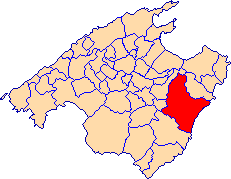Manacor
| Manacor | |||
|---|---|---|---|
| Municipality | |||
|
|||
 |
|||
| Location in Spain | |||
| Coordinates: 39°34′0″N 3°12′0″E / 39.56667°N 3.20000°ECoordinates: 39°34′0″N 3°12′0″E / 39.56667°N 3.20000°E | |||
| Country |
|
||
| Autonomous community |
|
||
| Province | Balearic Islands | ||
| Comarca | Llevant | ||
| Judicial district | Manacor | ||
| Government | |||
| • Mayor | Pedro Rosselló Cerdá (2015) (PP) | ||
| Area | |||
| • Total | 260.31 km2 (100.51 sq mi) | ||
| Elevation | 80 m (260 ft) | ||
| Population (2008) | |||
| • Total | 39,434 | ||
| • Density | 150/km2 (390/sq mi) | ||
| Demonym(s) | Manacorí | ||
| Time zone | CET (UTC+1) | ||
| • Summer (DST) | CEST (UTC+2) | ||
| Postal code | 07500 | ||
| Website | Official website | ||
Manacor (Catalan pronunciation: [mənəˈkɔ]) is a town and municipality on the island of Mallorca, part of the Spanish autonomous community of the Balearic Islands. It has tourist areas like Porto Cristo, site of the famous Caves of Drach, and Cales de Mallorca. Manacor has one of the busiest street markets on the island, held every Monday morning. Manacor is famous for furniture manufacture and artificial pearls.
The first indications of human occupation in the area of Manacor go back to 2000-1200 BC. Of this period are the artificial coves as burial places (cova de s'Homonet at Son Ribot, Mitjà de ses Beies at Sa Sínia Nova, etc.), and a type of construction similar to the naveta, either isolated or grouped in villages, which were used as living spaces (sa Marineta, s'Hospitalet Vell, etc.)
Of the megalithic Talaiot culture, the most outstanding constructions are s'Hospitalet Vell, es Boc, Bellver, as well as the constructions of Bendrís, Son Sureda and Sa Gruta.
The origin of the town of Manacor goes back to the times before the Islamic dominance. The submarine discoveries of objects found in Porto Cristo show that it was a Roman port. The remains of the basilicas of sa Carrotja and son Peretó prove the existence of well-established Christian communities.
After the invasion launched by James I of Aragon, Nuño Sánchez received from him the land of Manacor. In 1300, James II granted Manacor a statute of municipality. The Torre del Palau and the fortification of some rural houses like the Torre de ses Puntes and the Torre dels Enagistes have been preserved from the beginnings of town planning at Manacor. A native of Manacor, Simó Tort, was a character in medieval social conflicts.
Saint Vincent Ferrer came to Manacor in 1414. In 1576 the convent dedicated to the saint was founded, and after this the construction of the baroque church began. At the beginning of the following century the construction of the cloister began.
...
Wikipedia



